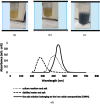Biomimetic synthesis of iron oxide nanoparticles from Bacillus megaterium to be used in hyperthermia therapy
- PMID: 36402871
- PMCID: PMC9675886
- DOI: 10.1186/s13568-022-01490-y
Biomimetic synthesis of iron oxide nanoparticles from Bacillus megaterium to be used in hyperthermia therapy
Abstract
The suitable structural characteristics of magnetic nanoparticles have resulted in their widespread use in magnetic hyperthermia therapy. Moreover, they are considered a proper and operational choice for pharmaceutical nanocarriers. Using the biomimetic method, we were able to produce iron oxide magnetic nanoparticles from the bacterial source of PTCC1250, Bacillus megaterium, for therangostic diagnosis systems and targeted drug delivery. Some of the benefits of this method include mitigated environmental and biological dangers, low toxicity, high biocompatibility, cheap and short-term mass production possibilities in each synthesis round compared to other biological sources, simple equipment required for the synthesis; and the possibility of industrial-scale production. Bacillus megaterium is a magnetotactic bacteria (MTB) that has a magnetosome organelle capable of orienting based on external magnetic fields, caused by the mineralization of magnetic nanocrystals. Utilizing this capability and adding an iron nitrate solution to the bacterial suspension, we synthesized iron oxide nanoparticles. The extent of synthesis was measured using UV-visible spectrophotometry. The morphology was evaluated using FESEM. The crystallized structure was characterized using RAMAN and XRD. The size and distribution of the nanoparticles were assessed using DLS. The surface charge of the nanoparticles was measured using zeta potential. The synthesis of iron oxide nanoparticles was confirmed using FT-IR, and the magnetic property was measured using VSM. This study is continued to identify industrial and clinical applications.
Keywords: Bacillus megaterium; Hyperthermia; Iron oxide; Nano-biomimetic.
© 2022. The Author(s).
Conflict of interest statement
Not applicable.
Figures





Similar articles
-
Biosynthesis Optimization of Antibacterial-Magnetic Iron Oxide Nanoparticles from Bacillus megaterium.Biol Trace Elem Res. 2025 Jan;203(1):467-484. doi: 10.1007/s12011-024-04168-7. Epub 2024 Apr 12. Biol Trace Elem Res. 2025. PMID: 38607527
-
Synthesis and characterization of glycyrrhizic acid coated iron oxide nanoparticles for hyperthermia applications.Mater Sci Eng C Mater Biol Appl. 2017 Aug 1;77:1060-1067. doi: 10.1016/j.msec.2017.04.015. Epub 2017 Apr 4. Mater Sci Eng C Mater Biol Appl. 2017. PMID: 28531979
-
pH-responsive glycine functionalized magnetic iron oxide nanoparticles for SARS-CoV-2 RNA extraction from clinical sample.J Mater Sci. 2022;57(28):13620-13631. doi: 10.1007/s10853-022-07464-6. Epub 2022 Jul 13. J Mater Sci. 2022. PMID: 35855687 Free PMC article.
-
Bio-synthesized iron oxide nanoparticles for cancer treatment.Int J Pharm. 2020 Aug 30;586:119472. doi: 10.1016/j.ijpharm.2020.119472. Epub 2020 Jun 23. Int J Pharm. 2020. PMID: 32590095 Review.
-
Learning from magnetotactic bacteria: A review on the synthesis of biomimetic nanoparticles mediated by magnetosome-associated proteins.J Struct Biol. 2016 Nov;196(2):75-84. doi: 10.1016/j.jsb.2016.06.026. Epub 2016 Jul 1. J Struct Biol. 2016. PMID: 27378728 Review.
Cited by
-
Iron Oxide Nanoparticles: Green Synthesis and Their Antimicrobial Activity.Nanomaterials (Basel). 2023 Nov 8;13(22):2919. doi: 10.3390/nano13222919. Nanomaterials (Basel). 2023. PMID: 37999273 Free PMC article. Review.
-
Functional roles of magnetic nanoparticles for the identification of metastatic lymph nodes in cancer patients.J Nanobiotechnology. 2023 Sep 21;21(1):337. doi: 10.1186/s12951-023-02100-0. J Nanobiotechnology. 2023. PMID: 37735449 Free PMC article. Review.
-
Targeting Peptides: The New Generation of Targeted Drug Delivery Systems.Pharmaceutics. 2023 Jun 3;15(6):1648. doi: 10.3390/pharmaceutics15061648. Pharmaceutics. 2023. PMID: 37376097 Free PMC article. Review.
-
Iron Oxide@Mesoporous Silica Core-Shell Nanoparticles as Multimodal Platforms for Magnetic Resonance Imaging, Magnetic Hyperthermia, Near-Infrared Light Photothermia, and Drug Delivery.Nanomaterials (Basel). 2023 Apr 12;13(8):1342. doi: 10.3390/nano13081342. Nanomaterials (Basel). 2023. PMID: 37110927 Free PMC article. Review.
-
Biosynthesis Optimization of Antibacterial-Magnetic Iron Oxide Nanoparticles from Bacillus megaterium.Biol Trace Elem Res. 2025 Jan;203(1):467-484. doi: 10.1007/s12011-024-04168-7. Epub 2024 Apr 12. Biol Trace Elem Res. 2025. PMID: 38607527
References
-
- Arsalani S, Guidelli EJ, Araujo JF, Bruno AC, Baffa O. Green synthesis and surface modification of iron oxide nanoparticles with enhanced magnetization using natural rubber latex. ACS Sustain Chem Eng. 2018;6(11):13756–13765. doi: 10.1021/acssuschemeng.8b01689. - DOI
LinkOut - more resources
Full Text Sources

